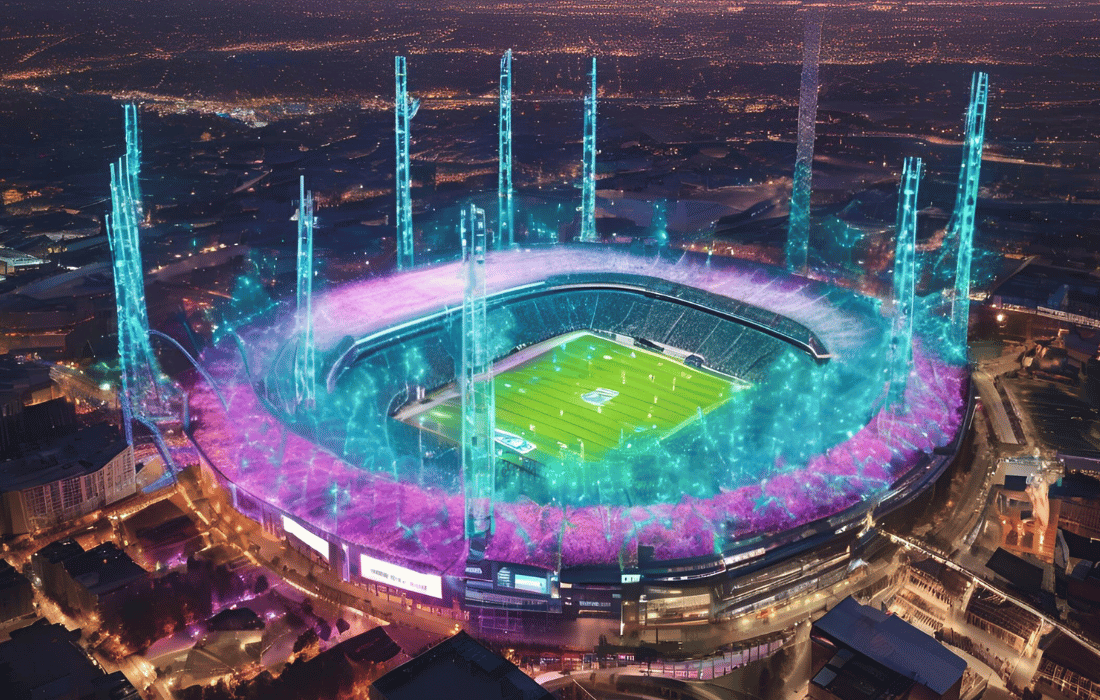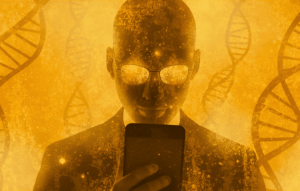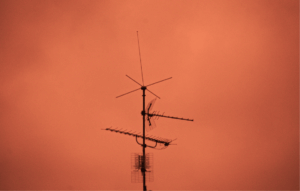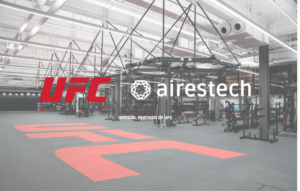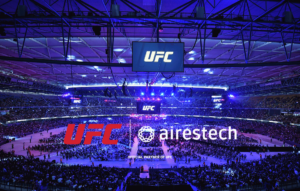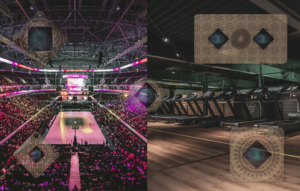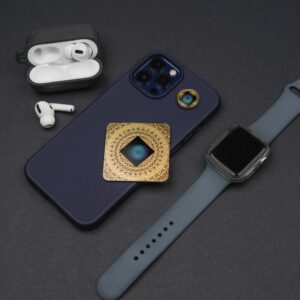Gone are the days when you showed up to a game, grabbed a hot dog, and squinted at the scoreboard between plays. Today’s stadiums are morphing into tech-fueled ecosystems—mini smart cities buzzing with augmented reality, AI-enhanced workflows, lightning-fast cashless payments, and yes, 5G. It’s all happening faster than most fans realize.
Companies like Orange Business, Extreme Networks, and Verizon are leading this stadium revolution, making everything more immersive, efficient, and connected. From instant photo uploads to real-time stats beamed straight to your phone, the fan experience has become a digital playground.
But while we marvel at the upgrades, there’s a quieter conversation that rarely makes it to the jumbotron: What does all this wireless radiation mean for our health?
How 5G Is Elevating the Live Sports Experience
As Guillaume Chabas of Orange Business puts it, stadiums are becoming small cities. They need to cater not just to tens of thousands of fans, but to broadcasters, vendors, security teams, and operations staff. Private 5G networks are the backbone of this digital machine, allowing every part to function in real-time, without the delays that plagued earlier wireless networks.
AR-powered apps like Immersiv.io turn smartphones into data lenses—aim your camera at the pitch and get heat maps, player stats, and even replays on demand. Think of it as fantasy football merged with real-time optics.
Touch2See: Making Sports Inclusive
One of the more heartening innovations is Touch2See, a tactile tablet interface for visually impaired fans. With live haptic feedback mimicking the ball’s movement, users can feel the rhythm of the game while listening to audio descriptions. It’s inclusive tech at its best—something the sports world desperately needs more of.
Operations Go Digital
It’s not just about fans. Photographers now use 5G+ to beam shots directly from their cameras to news agencies. AI tools like Moment Lab instantly tag images, recognizing players and even brand placements. Meanwhile, concessions run more smoothly with prioritized network slicing to prevent transaction failures during halftime rushes.
In short, stadiums are evolving from analog giants to digital marvels. And there’s no slowing down.
The Hidden Cost: Wireless Radiation Is Also Increasing
The power and speed of 5G stem from its use of millimeter waves (mmWave), a form of high-frequency radiation that allows for massive data transfers with extremely low latency. But those same frequencies also penetrate the body differently than previous generations of wireless tech. They don’t travel as far, so more transmitters are needed—often at closer proximity.
That’s why you’ll find 5G small cell antennas on light poles, ceilings, even in stadium seats. And each one pulses out electromagnetic fields (EMFs), contributing to an invisible blanket of radiation that surrounds fans, staff, and athletes alike.
What the Science Says
Several studies have shown that prolonged exposure to RF radiation, including 5G frequencies, has been associated with oxidative stress, cellular damage, and disruption of DNA repair mechanisms. Studies on animals have shown behavioral and neurological changes, reproductive issues, and an increase in oxidative biomarkers.
Studies show that 5G EMFs activate voltage-gated calcium channels (VGCCs), triggering a flood of intracellular calcium, which leads to free radical damage and increased risk of inflammation.
The BioInitiative Report, an extensive compilation of over 1,800 studies, concludes that chronic exposure to RF-EMFs can impair cognition, alter gene expression, and disrupt sleep cycles.
Athletes may be particularly vulnerable. Their bodies are already under tremendous oxidative and physiological stress from intense physical exertion. Add EMF exposure into the mix, and you’re looking at potential disruptions to cellular repair, hydration levels, testosterone production, and nervous system recovery.
Stadiums as Radiation Hotspots
Stadiums pack tens of thousands of people into a dense area filled with devices—phones, tablets, cameras, wearables. Then add hundreds of antennas, private 5G slices, Bluetooth-enabled food kiosks, and biometric ticket scanners. It’s the perfect storm for EMF overload.
And because 5G waves don’t penetrate walls well, signal boosters and small cells are often installed every 100 feet or so within the venue. This creates constant, low-range exposure that’s harder to escape than in everyday environments.
Athletes and Performance Tech
Let’s not forget the athletes themselves. Many now wear biometric sensors, smart pads, and wireless communication gear. While these tools can enhance gameplay and safety, they also increase RF exposure significantly. The irony? Some of the most health-optimized humans on earth are becoming guinea pigs for untested long-term effects.
Aires: Leading the Way in Athlete EMF Protection
As the conversation around EMF exposure in sports intensifies, Aires Tech has stepped up as the only wellness-tech company proactively transforming high-performance environments for elite athletes and fans alike.
UFC Performance Institute and Aires
In one of the most exciting wellness-tech collaborations in professional sports, Aires Tech has partnered with the UFC and the UFC Performance Institute to bring its EMF-protective solutions directly into athlete training spaces. These aren’t just theoretical upgrades—this is about performance, recovery, and longevity.
The UFC Performance Institute, already known for cutting-edge performance analytics, now integrates Aires Tech devices to help mitigate the constant radiation stress from wireless devices and smart equipment. Considering that MMA athletes operate at the razor’s edge of human potential, it only makes sense to protect their biological systems from every unnecessary stressor—especially one as invisible and overlooked as EMF.
The Target Center: The First Aires Certified Arena
A historic moment came in early 2025 when the Minnesota Timberwolves’ home court—the Target Center in Minneapolis—became the world’s first official Aires Certified Space™. This designation isn’t just symbolic. It means Aires devices are installed at every Wi-Fi access point throughout the facility, helping neutralize radiation from the massive EMF load of modern tech infrastructure.
The Timberwolves are pioneering a movement toward holistic athletic wellness, recognizing that EMF exposure could be quietly eroding recovery, sleep quality, mental focus, and hormone health in both athletes and fans. By creating an EMF-optimized space, they’re giving their team a true competitive edge—and setting a new gold standard for arenas worldwide.
Aires Certified Spaces™ and the Future of Public Wellness
Aires Certified Spaces™ reflect a profound shift in how we think about health in public settings. As EMFs from wireless tech grow exponentially, so does the need to harmonize those fields. Aires doesn’t block EMFs—it transforms them, making them biologically compatible with the human body. This makes Aires the perfect bridge between connectivity and wellness.
This innovation isn’t limited to sports. Aires envisions its tech in schools, offices, and airports—anywhere people are surrounded by wireless infrastructure. The Target Center is just the beginning.
What Can Be Done?
As stadium tech continues to evolve at a breakneck pace, it’s crucial we pause and ask: how do we protect ourselves without rejecting progress? The good news is, there are actionable steps we can take—whether you’re a fan in the bleachers or an athlete in the spotlight.?
Mitigation Measures

Save 25% on Aires EMF protection devices with code “MOL” Shielding devices: Aires offers a range of scientifically backed EMF protection devices for personal, home, and commercial use.
Distance and duration: Keeping devices off your body and on airplane mode when not in use helps. The closer the source, the higher the radiation load.
Optimize recovery: Supporting the body’s detox pathways through grounding, sauna use, antioxidant supplementation (like glutathione or vitamin C), and mitochondrial support (CoQ10, PQQ) can help offset some of the biological stress.
Policy and Awareness
Public conversations around EMF are still in their infancy. Stadiums are investing heavily in tech innovation—but not enough in precautionary design. Clear signage about radiation zones, EMF monitoring tools, and designated low-EMF areas could be a step in the right direction.
The Inevitable Rise of 6G—and What That Means
If you think 5G is intense, just wait for 6G.
Projected for commercial rollout by 2030, 6G will operate at terahertz frequencies, making today’s ultra-fast connections look like dial-up. The data potential is extraordinary, but so are the health unknowns. As the race toward smarter stadiums and immersive sports continues, it’s critical we don’t sideline our biological limits in the name of digital progress.
Conclusion: Tech Triumph with a Caution Flag
There’s no doubt 5G is revolutionizing live sports. From immersive AR to efficient press workflows, it’s reshaping what we expect from a game-day experience. But let’s not ignore the cost of hyperconnectivity.
We can embrace innovation while still advocating for health-first design. After all, the ultimate goal should be longevity—not just in our networks, but in the athletes and fans who breathe life into the game.

